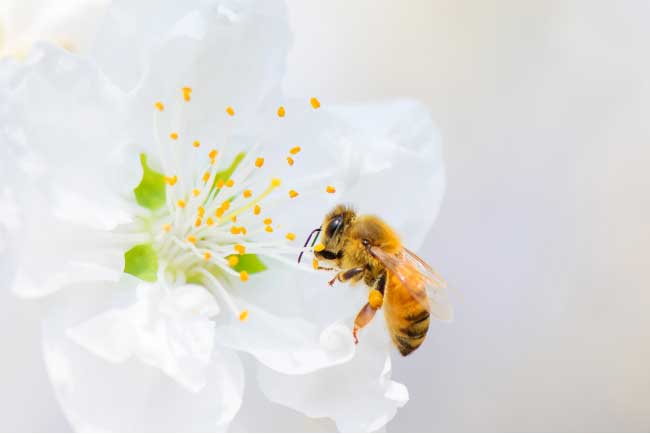By James G. Miller, Certified Master Beekeeper
As you read this article sit back in your easy chair with your coffee cup in hand and let your mind’s eye start looking around. Go to the refrigerator and open the door. What do you see? There are vegetables and fruits that you purchased or removed from your garden. How did they get there? If they are from your garden you sowed the seed, watered and cared for them. Then finally harvested them and placed them into the refrigerator. For those that were purchased from a local store, someone planted the seed, someone cared for them, and someone harvested, cleaned, and transported them to the local store. One important step has been missed in both these processes.

Over ninety percent of the produce that we consume as humans has been pollinated by bees, either native pollinators or the honey bee. Honey bees are the most successful pollinators we have. During the summer months they work themselves to death. They fly from flower to flower transferring pollen and collecting nectar. This pollen transfer makes sure the flower will reproduce fruits and vegetables. Some of the results are beautiful looking flowers that grow around our homes. Other results are food on our tables. Unfortunately the native pollinators and honey bees are in trouble.
Farmers need to remove weeds and harmful pests from the crops to make a living. Home owners want to remove weeds from the landscapes. This will make their homes more desirable. The most common solution is to employ the use of chemicals, pesticides and herbicides. Let’s get the sprayer out and coat those nasty weeds and bugs with chemicals. But wait a minute. What will we be doing to our pollinators?
Currently the use of chemicals such as Neonicatodes is being used to kill weeds. This helps reduce the time for the farmer to produce a crop, but not his costs. The Neonicatodes are designed to enter the root system of the weed and kill it. For the bugs that are harmful to the plant the Neonicatodes are sprayed on the plant. In some cases the chemical kills the bug(s) out right but the majority of the chemical enters the plant through the root system. It then travels up the root system into the flower where it becomes part of the nectar and pollen. The pollinators come to the flower for those items.
Once the pollinator has digested either the pollen or nectar the chemical is transferred to the insect. The chemicals do different things to the insect but the end results are the same death. How can we, the average citizen, help the native pollinators, honey bees and butterflies?
We can reduce the amount of pesticides and herbicides used around the home. Another help for the pollinators is to plant flowers that are useful for them. There is a parasite on the honey bee which is called a mite. There are two types, one walks into the windpipe and reproduces. The other walks on the exterior of the honey bee and reproduces in the brood chamber. Both siphon the bodily fluids from the honey bees. One way of helping the honey bee is to provide thymol fluid. Thymol is a product of the thyme plant. We can plant thyme in the garden or flower beds. When the thyme blooms, the honey bee can obtain the nectar and pollen from the plant. When the mites digest the thymol they become sterile and unable to reproduce. Any of the herbs that are planted and bloom will also assist the honey bee in being healthy.
Currently we don’t use chemicals to assist our pollinators or honey bees here at Millers Homestead. We have started to plant different native flowers that they like. When the hive looks sick we provide a mixture of essential oils that help them to recover. These essential oils are similar to what we, as humans, use to help us maintain our health. We don’t treat honey bees unless they are sick.
Where did we get this idea to use essential oils? Several years ago our government sent me to the Republic of Georgia on the Black Sea and most recently to Egypt. The idea was for me to teach them how to become beekeepers. One of our common honey bees comes from the Georgian region, the Caucasian Honey Bee. The Georgian’s have been beekeepers for several thousand years. The Egyptians have been beekeepers longer and with a different climate. Guess who taught whom and what information was transferred.
Sources:
International Bee Research Association, London, England
The Buzz about Bees, Biology of a Superorganism, Dr. Jurgen Tautz
The Handbook for the Bee Loving Beekeeper, James G. Miller, Master Beekeeper

